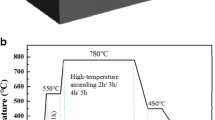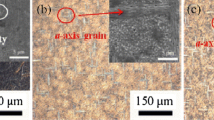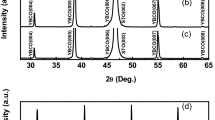Abstract
High-performance YBa2Cu3O7−z (YBCO) super conducting films have been prepared on single-crystal substrate by fluorine-free polymer-assisted metal organic deposition (PA-MOD) method. The introduction of polymers into the precursor solution can make the coating solution more homogeneous and stable. And, the novel high temperature partial melting process can enhance the epitaxial growth of the precursor films. The influence of partial melting time on the texture, microstructure, and properties was thoroughly investigated. The results indicate YBCO film melting for 5 min has biaxial texture, smooth and dense microstructures, as well as high critical current density (77 K, 0 T) over 3 MA/cm2.
Similar content being viewed by others
Explore related subjects
Discover the latest articles, news and stories from top researchers in related subjects.Avoid common mistakes on your manuscript.
1 Introduction
In recent years, the second-generation YBa2Cu3O7−z (YBCO) high-temperature superconducting tapes or wires, i.e., coated conductors, attract much attention worldwide [1, 2]. YBCO-based coated conductors are promising in applications such as transmission cables, motors, generators, and magnetic energy storage system, due to the high critical current density and large irreversibility filed [3, 4]. However, the high vacuum deposition approach such as pulse laser deposition [5, 6] with high cost limits the large-scale commercial applications of the coated conductors. As we know, the chemical solution deposition (CSD) [7, 8] method can offer versatile and cost-effective processing routes with controlled stoichiometry and microstructures. In view of the real situation, the CSD method has been proposed to prepare the YBCO super layer, which is especially significant to improve the performance of the coated conductors. In the past 10 years, high properties YBCO film has been obtained with the critical current density over 1 MA/cm2 by different kinds of CSD methods [9, 10]. Among these methods, the trifluoroacetates metal organic deposition [11, 12] has been frequently reported for the fabrication of YBCO film with high critical current density on single-crystal substrates, IBAD substrates, and rolling-assisted biaxial-textured substrates [13–15]. But for the intricate process of fluorine removal and the complicated reactor designs in fluorine-containing method [9], non-fluorine approaches attract more attention recently.
In this work, a self-developed polymer-assisted metal organic deposition (PA-MOD) method [16, 17] has been used to prepare the YBCO films on single-crystal substrates. Compared to the conventional synthesis process of the coating solutions, the introduction of polymers can not only effectively adjust the viscosity of the coating solutions but can also form the covalent bond between the metal cations and polymers. It means the metal cations will be constrained by the polymers, thus making the coating solutions homogeneous and stable. In addition, the high-temperature partial melting process for a short time has been newly introduced to fabricate the high-performance YBCO films. This new heat treatment process can enhance the epitaxial growth of the YBCO precursor films. The results indicate YBCO films possess biaxial texture, dense and smooth microstructures, and high critical current density (77 K, 0 T) over 3 MA/cm2.
2 Experimental
YBCO films were prepared on LAO (00l) single-crystal substrate by F-free PA-MOD method. The precursor solution was synthesized by dissolving yttrium, barium, and copper acetates in propionic acid with stoichiometry to obtain a transparent green solution. Then amount of polymer polyvinyl butyral (PVB) was incorporated into the precursor solution with being subsequently subjected to continuous stirring. After stirring for several hours, the coating solution was prepared with homogeneity and viscosity as expected. A spin coater was used to coat the films on LAO substrate, and the coated films were dried at 100–150∘ for 10 min.
The wet gel films were treated with three stages in order to fabricate the superconducting films. Firstly, the wet gel films were dried in dry Ar gas, then decomposed by heating them to 500∘ with a ramp of 0.5∘/min in humidified Ar and O2 mixture gas to achieve amorphous matrix with nanocrystallines of the Y, Ba, and Cu oxides. Secondly, the pyrolysed films were partially melted at a high temperature above 810∘ for several minutes in the dry Ar and O2 mixture gas. Then the films were subjected to the YBCO phase conversion and crystal growth process with dwelling at 770∘ for an hour. Finally, oxygenation annealing was performed in dry O2 gas at 450∘ for an hour to obtain the superconducting YBCO films. The humidified ambient was obtained by passing dry gas through a reservoir of water, in which the humidity can be controlled by the water temperature, i.e., dew point of water.
The heating process of the metal organic precursors was determined by means of differential thermal analysis/thermogravimetric analysis (DTA/TGA) measurements on dried powders. A Philips X’Pert MRD diffractometer with CuK α radiation was used to record the 𝜃–2 𝜃XRD patterns, which characterized the phase purity of the as-grown film. The texture analyses including φ scan and ω scan were performed using a Philips MRD equipped with a fourcrystal monochromator, delivering a pure CuK α1 line of wavelength λ = 0.15406 nm. The microstructure analyses as well as the cross-sectional investigation of the YBCO layer were performed by using a scanning electron microscope (SEM, Quanta 200, FEI) equipped with an energy dispersive spectrometer (EDS). Superconducting transition and magnetic hysteretic loops were measured by using a SQUID magnetometer (Quantum-Design XL7). The inductive critical current density J c was determined with the extended Bean model [18] from the M-H loops.
3 Results and Discussion
Figure 1 a shows the TGA/DTA analysis of the dried gel from the PA-MOD coating solution under Ar and O2 mixture gas. More than 50 % weight loss is between 200 and 450∘ and most of the weight loss is due to the decomposition of the organic compounds. However, an endothermic peak has been detected around 805∘, which means the happening of melting reaction in the powder system. The SEM micrograph of YBCO precursor film quenched from the partial melting temperature of 815∘ (dwelling for 5 min) is shown in Fig. 1b. The grain edges become very blunt and some of the grains even melt together without clear grain boundaries, indicating the existence of partial melting reaction during this high-temperature treating process.
To further investigate the partial melting process, the typical 𝜃–2 𝜃X-ray diffraction patterns of YBCO films with different melting times are shown in Fig. 2. It can be seen all the films have pure (00l) single-crystal diffraction peaks except the peaks of LAO substrate. With increasing the partial melting time from 2 to 5 min, the diffraction intensity of the YBCO films gradually increase. However, the diffraction intensity begins to decrease as the partial melting time further increase to 15 min. Accordingly, YBCO film partial melting at 815∘ for 5 min has better c-axis orientation than other films.
Besides the good c-axis grain alignment, YBCO film with the melting time of 5 min also has enhanced biaxial texture, as shown in Fig. 3. The full width at half maximum (FWHM) of (103) phi scan is 1.2∘ (Fig. 3a), indicating a good in-plane texture. And the FWHM of (005) omega scan is 0.2∘ (Fig. 3b), indicating a good out-of-plane texture. The results show the film treating at 815∘ for 5 min possesses excellent biaxial texture, which may be attributed to the improved wetting ability between the YBCO precursor film and the substrate under this high-temperature partial melting treatment.
The SEM micrographs of YBCO films with different melting times are shown in Fig. 4. It can be seen in Fig. 4a that the film melting for 2 min has few c-axis-oriented grains and many disordered polycrystalline grains. With increasing the melting time to 5 min, the film has dense and crack-free microstructures indicating better grain connectivity, shown in Fig. 4b. The thickness of the film is about 330 nm, as shown in Fig. 4d. However, the film with a melting time of 15 min in Fig. 4c displays lots of disordered polycrystalline grains, and the grain connectivity declines obviously. The results demonstrate that the effect of melting time on the texture and microstructures is of great importance. The proper melting time can generate few liquid phase in the precursor film and increase the wetting ability between the precursor film and substrate, thus enhance the epitaxial growth of the precursor film. In addition, the liquid phase generated under the proper melting time can close part of the microholes in the precursor film. While the short melting time cannot produce enough liquid phase, much liquid phase due to the long melting time may destroy the homogeneity and stability of the film. This is the reason for worse texture and microstructures of the films with short and long melting time.
Figure 5a shows the temperature dependence of magnetic moment for YBCO films with different melting times. The superconducting transition temperature about 90 K and a narrow transition width have been obtained for all the YBCO films, indicating the good superconductivity of the films. However, the film with melting time of 5 min has the highest diamagnetic signal, demonstrating purer YBCO superconducting phase. Figure 5b shows the field dependence of critical current density (J c) for YBCO films with different melting times. As can be seen, the film with a melting time of 5 min has the largest J c values in the magnetic fields at 77 and 50 K. Compared with the film melting for 5 min, the J c values of other two films reduce more quickly in the magnetic fields. Especially, the film with melting times of 2 and 15 min has the irreversibility field of 1 T at 77 K, while the irreversibility field of the film with a melting time of 5 min is above 3 T at 77 K. The results demonstrate that the film with a melting time of 5 min has better properties than other films, which is due to the better c-axis texture and grain connectivity.
4 Conclusion
The TGA/DTA analysis of the dried gel from the PA-MOD coating solution demonstrates that there is a melting reaction about 805∘ in the powder system. And the grains of the precursor film quenched above this temperature has become blunt and even melted together without clear grain boundaries, which further proves the happening of the melting reaction. The results show that the films melting for different times have different structures and performance. The film melting for 5 min possesses better c-axis texture and denser surface microstructure than other films. Additionally, the film melting for 5 min has larger diamagnetic signal and higher in-field J c values at different temperatures, indicating better properties.
References
Obradors, X., Puig, T., Pomar, A., Sandiumenge, F., Mestres, N., Coll, M., Cavallaro, A., et al.: Supercond. Sci. Technol. 19, S13 (2006)
Obradors, X., Puig, T.: Supercond. Sci. Technol. 27, 044003 (2014)
Chen, Z., Kametani, F., Chen, Y., Xie, Y., Selvamanickam, V., Larbalestier, D.C.: Supercond. Sci. Technol. 22, 055013 (2009)
Larbalestier, D.C., Gurevich, A., Feldmann, D.M., Polyanskii, A.: Nature 368, 414 (2001)
Usoskin, A., Dzick, J., Issaev, A., Knoke, J., Garcia-Moreno, F., Sturm, K., et al.: Supercond. Sci. Technol. 14, 676 (2001)
Yamada, Y., Takahashi, K., Kobayashi, H., Konishi, M., Watanabe, T., et al.: Appl. Phys. Lett. 87, 132502 (2005)
Qiao, Y., Li, Y., Sathiraju, S., Reeves, J., Lenseth, K., Selvamanickam, V.: Physica C 48, 382 (2002)
Motowidlo, L.R., Selvamanickam, V., Galinski, G., Vo, N., Haldar, P., Sokolowski, R.S.: Physica C 335, 44 (2000)
Xu, Y.L.: High Jc epitaxial YBa2Cu3O7−d films through a non-fluorine approach for coated conductor applications, Ph.D dissertation. University of Cincinnati (2003)
Tsukada, K., Yamaguchi, I., Sohma, M., Kondo, W., Kamiya, K., Kumagai, T., et al.: Physica C 29, 458 (2007)
Gutiérrez, J., Llordes, A., Gázquez, J., Gibert, M., Romá, N., Ricart, S., Pomar, A., et al.: Nat. Mater. 6, 367 (2007)
Wei, W., Feng, F., Zhao, Y., Xiao, T., Yunran, X., Kai, S., et al.: Supercond. Sci. Technol. 27, 055006 (2014)
Ymada, Y., Kim, S.B., Araki, T., Takahashi, Y., Yuasa, T., Kurosaki, H., et al.: Physica C 357–360, 1007–1010 (2001)
Minei, T., Tanaka, T., Ogata, M., Mori, N., Yamada, K., Mukaida, M.: Physica C 570, 445–448 (2006)
Izumi, T., Honjo, T., Tokunaga, Y., Fuji, H., Teranishi, R., Iijima, Y., et al.: IEEE Trans. Appl. Supercond. 13, 2500 (2003)
Wang, W.T., Pu, M.H., Li, G., Sun, R.P., Zhou, H.M., Zhao, Y., et al.: Physica C 468, 1563 (2008)
Wang, W.T., Pu, M.H., Yang, Y., Zhang, H., Cheng, C.H., Zhao, Y.: Physica C 470, 1261 (2010)
Bean, C.P.: Rev. Mod. Phys. 31, 36 (1964)
Acknowledgments
The authors are grateful for the financial support of the National Science Foundation of China under Grant Nos. 51102199, 51271155, 51377138, and 51202202; the National Magnetic Confinement Fusion Science Program under Grant Nos. 2011GB112001 and 2013GB110001; the Program of International S&T Cooperation under Grant No. 2013DFA51050; and the 863 Program under Grant No. 2014AA032701.
Author information
Authors and Affiliations
Corresponding authors
Rights and permissions
About this article
Cite this article
Wang, W.T., Wang, Z., Pu, M.H. et al. A Novel Partial Melting Process for YBa2Cu3O7−z Superconducting Films by Fluorine-Free Polymer-Assisted Metal Organic Deposition Approach. J Supercond Nov Magn 28, 3249–3253 (2015). https://doi.org/10.1007/s10948-015-3164-9
Received:
Accepted:
Published:
Issue Date:
DOI: https://doi.org/10.1007/s10948-015-3164-9









